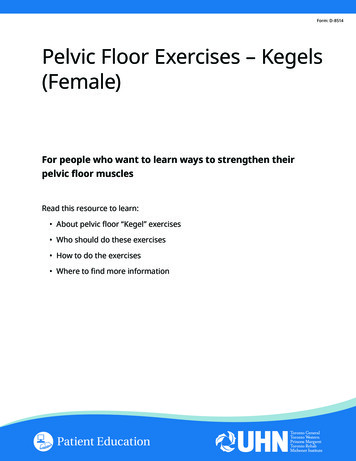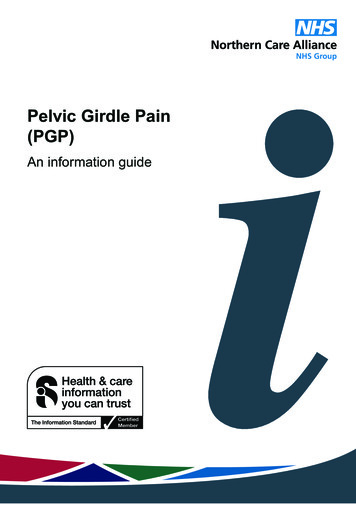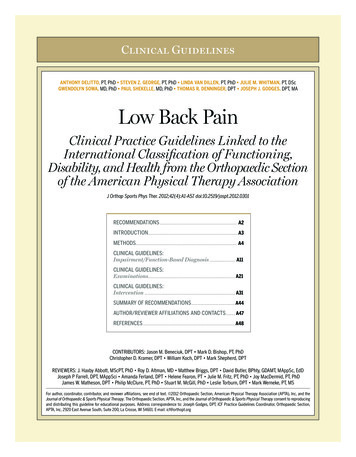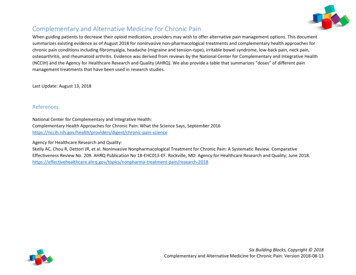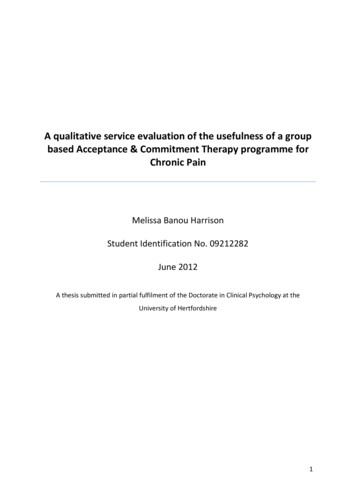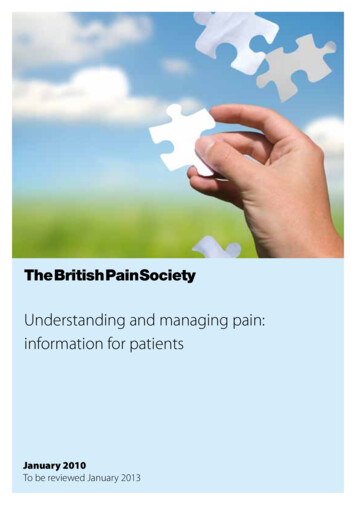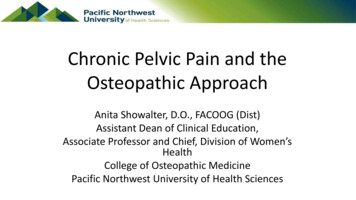
Transcription
Chronic Pelvic Pain and theOsteopathic ApproachAnita Showalter, D.O., FACOOG (Dist)Assistant Dean of Clinical Education,Associate Professor and Chief, Division of Women’sHealthCollege of Osteopathic MedicinePacific Northwest University of Health Sciences
No disclosures
Objectives Be able to list the various causes of pelvic pain Understand the underlying etiology of conditions causing pelvic pain Describe an approach to diagnosis and treatment for GYN pain withan osteopathic approach to safely reduce costs and improveoutcomes.
Acute vs Chronic Pelvic Pain Acute pain n torsionEctopic pregnancySomatic dysfunction Chronic Pelvic Pain - more than 6 months duration Significantly impacts activities of daily living and the patient’s quality of life Reproductive and non-reproductive organ related pain Primarily acyclic Present all the time, may exacerbate with the menses
OMT in Acute Pain Determine whether the pain may indicate a life-threatening condition––––OMT is not indicated in emergenciesPerform your usual pelvic examNote cervical position – Is it deviated?Note uterus – Anteverted? Retroverted? Tender? Is retroverted really normal?– More dysmenorrhea– More miscarriages– More risk of prolapse– Note adnexal tissue tension, tenderness and turgor– Note vaginal tissue tension, tenderness and turgor– Note pelvic floor tissues, symmetry, tenderness, tension
Structural Exam for the GYN Patient– Look for asymmetry of the ASIS– Check for tenderness of the pubic bone– Look for vertical and AP shears AP shears can cause significant pelvic pain and suprapubic tenderness Suprapubic tenderness not related to somatic dysfunction may be interstitialcystitis––––Pelvic compression test for SI dysfunction“Structural exam” includes structure of the uterus and adnexaCheck the psoas and abdominal wall for tendernessTreat abnormal findings and recheck the pelvic exam for changes
Pelvic Floor Dysfunction
OMT saves time and health care dollars If the problem resolves with OMT, further work up may notbe needed If relief is short (returns within 24 hours) the problem maybe viscerosomatic and require further work up After diagnostic laparoscopy, pain may improve for severalmonths– May be due to paralyzing agents used in anesthesia induction– Deep relaxation and resetting of tissue tension may temporarilyrelieve pain from somatic dysfunction
Possible Origins of Chronic Pelvic Pain GynecologicSomatic dysfunction (osteopathic ogicPsychosomatic
Nerves with Pain Fibers from Pelvic Origin
Creative ns/thumb/f/fd/1501 Connections of the Sympathetic Nervous System.jpg/408px-1501 Connections of the Sympathetic Nervous System.jpg
Viscerosomatic Convergence Phenomenon that causes pain to be diffusely experienced in thesensory cortex Second order neurons receive both visceral and somatic input Viscerosomatic neurons have larger receptive fields than the somatic ones Pain is usually referred to the skin Genital tract sensitivity varies by location Upper vagina is less sensitive than the lower vaginaCervix is insensitive to small biopsies but sensitive to deep incision or dilationsUterus is very sensitiveOvaries are relatively insensitive except for rapid distension or compression Ovarian torsion is very painful (ischemia with rapid capsular distension) Ovarian cancer is not painful (slow distension)
Associated Symptoms - Gynecologic DyspareuniaDysmenorrheaAbnormal bleedingDischarge
Associated Symptoms - Gastrointestinal ConstipationDiarrheaBloatingGasRectal BleedingCreative stomach pains.jpg/234091608/322x175/stomach pains.jpg
Associated Symptoms - Genitourinary Urinary frequencyDysuriaUrgencyIncontinenceCreative Commons: Hunner’s ulcerhttp://i.ytimg.com/vi/gDtybIafNW8/0.jpg
Associated Symptoms - Neurologic Specific nerve distribution of ds/2012/07/RedNeuronal.jpg
Associated Symptoms – Somatic Dysfunction Diffuse pelvic pain Low back pain Unilateral lower quadrant pain (psoas spasm, psoas syndrome) Sciatica Lower extremity pain Dyspareunia DysuriaCreative ns/thumb/6/63/Gray404.png/250px-Gray404.png
Differential Diagnosis: Chronic Pelvic Pain In GYN EndometriosisAdenomyosisUterine leiomyomasPelvic congestion syndromePelvic inflammatory diseaseOvarian/Retroperitoneal cystsSomatic dysfunction– Recognize then treat or refer
Endometriosis Endometrial implants throughout thepelvis and abdomen Tend to be found in most dependentareas Can also be found systemically Progressive Causes infertility Decreased tubal mobility from adhesions Inflammation toxic to ova and sperm
Adenomyosis (Endometriosis Interna) Endometrial implants within the myometrium Do not cycle with menses Cause chronic inflammation ProgressiveCreative /6877e523c82ef6dfeaf0175be1ecc6 big gallery.jpeg
Adenomyosis - Gross PathologyCreative ns/thumb/a/ab/Adenomyosis, Hysterectomy Specimen.jpg/640px-Adenomyosis, Hysterectomy Specimen.jpg
Uterine Leiomyomas (Fibroids)OMT for symptomatic reliefMight early treatment be preventative?Creative ns/2/20/Leiomyoma of the Uterus.jpgCreative 55 1e674beec4 z.jpg
Uterine Leiomyomas (Fibroids) Treatment No treatment if asymptomatic Endometrial ablation - Microwave Myomectomy HysteroscopicLaparoscopicRoboticOpen Hysterectomy Consider GnRH agonist treatment for three monthsto decrease bulk and reduce blood lossCreative ation.jpgatment
Pelvic Inflammatory Disease Visceral techniques can be used to treat adhesions Adhesion stretching exercises Prevention is the best cureCreative ns/0/02/Adhesions.jpgCreative Commons: Fitz-Hugh-Curtis mages/PID adhesions.jpg
Chronic Pelvic Inflammatory Disease Examination– Diffuse pelvic pain– May have an adnexal mass if hydrosalpinx or a tubo-ovarian abscess is present– Decreased mobility of pelvic organs secondaryto adhesions Treatment– Diagnostic laparoscopy for adhesiolysis– Adhesions frequently return– Osteopathic visceral treatment to stretchadhesions– Prevention is the best cure!Creative ns/0/02/Adhesions.jpg
Pelvic Congestion Syndrome Pathophysiology––––Increased pelvic varicositiesIncreased congestion of pelvic organsPelvic organ mobilityMost women with pelvic varicosities are asymptomatic History––––Usually multiparousOften have a history of heavy liftingMay have associated menorrhagia and urinary frequencyCommonsIncreased by fatigue, standing, and intercourse ons/thumb/0/07/Gray586.png/250px-Gray586.png
Pelvic Congestion Syndrome Examination Diffuse pelvic pain Hypermobile uterus, retroverted, soft, boggy mildly enlarged Dilated veins may be noted on ultrasound and venographic studies Treatment Osteopathic manipulative treatment can reduce congestionCyclic suppression with hormonal contraception may improve symptomsLifestyle measures – reduce heavy lifting, jobs requiring standingHysterectomy may improve symptoms
Retroperitoneal Cysts Ultrasound– Generally will be simple cysts– May be difficult to determine whether or not they areretroperitoneal Treatment– Treatment is surgical– When in the retroperitoneal space, great care needs to be usednot to compromise the ureter and other important structures
Somatic Dysfunction Pathophysiology– Somatic dysfunction is defined by the presence of “TART” findings TendernessAsymmetryRestriction of motionTissue Texture changes History– History may include trauma MVA, falls, fractures– Note obstetric history Relaxin and stress of delivery predisposes to somatic dysfunction– Note activities that may cause repetitive trauma Lifting, sports– Ask about traumatic sexual assault/abuse Underlying tissue changes may be present
Somatic Dysfunction Structural Examination Pay attention to areas where pain is elicited and corresponding visceraDo a thorough examination of the pelvic floorNote the path of the psoas as a frequent contributor to pelvic painDo a structural exam for asymmetry and correct identified somaticdysfunction Repeat the examination after osteopathic manipulative treatment– When pain is of visceral origin, OMT may give temporary relief then recurswithin 24 hours– When pain is somatic, progressive improvement is noted with eachtreatment– Explain this to patient and if pain returns further work up is needed
PsoasCreative ns/c/c1/Musculus psoas minor.pngCreative 97 7cd7a543b0 z.jpg
Psychological Factors About 1/3 of patients will not receive a definitive diagnosis (under routine care –including osteopathic diagnoses will likely decrease undiagnosed cases) Psychological factors may be contributory to the pain, or may be secondary to it Patients with chronic pain have higher MMPI* scores in:– Anxiety– Hypochondriasis– Hysteria May have post-traumatic stress disorder from emotional, sexual or physicaltrauma*Minnesota Multiphasic Personality Inventory
Multidisciplinary Approach Sympathy Physical therapy – with pelvic floor expertise Osteopathic manipulation with core exercises– Fascial distortion model Relaxation, cognitive and behavioral therapies Evaluation for nerve entrapment
Pharmacologic Management Ovulation suppressionNSAIDsSSRI’sTricyclic antidepressantsGABA-ergic agentsLocal anesthetics (trigger point injections)
Surgical Management Could include hysterectomy, unilateral or bilateral salpingooophorectomy, adhesiolysis Complete psychological evaluation should be done before resorting tosurgery without a diagnosis With diagnostic laparoscopy, some patients will have improvedsymptoms for 3-4 months without other intervention– Consider a musculoskeletal/osteopathic diagnosis in these cases– Paralyzing agents used in anesthesia induction may allow for temporaryrelaxation and resetting of painful tissues Consider a trial of osteopathic manipulation and exercise beforesurgical intervention
References Hacker and Moore. Essentials of Obstetrics and Gynecology, 5th e.Chapter 21, Pelvic Pain. Pp 256-264. Elsevier, 2010 Bing Photos – Creative Commons Chila, Anthony et al. Foundations of Osteopathic Medicine. 3rde.Lippincott, Williams and Wilkins, 2011.
Hacker and Moore. Essentials of Obstetrics and Gynecology, 5th e. Chapter 21, Pelvic Pain. Pp 256-264. Elsevier, 2010 Bing Photos -Creative Commons Chila, Anthony et al. Foundations of Osteopathic Medicine. 3rd e.Lippincott, Williams and Wilkins, 2011.

